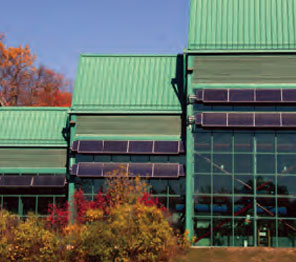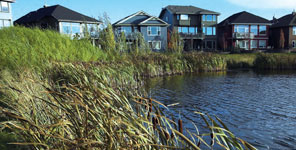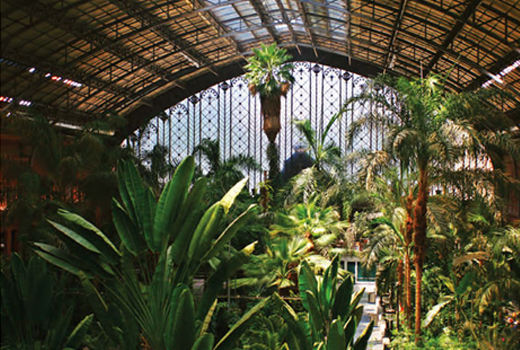A Living Systems Approach to Design
Sustainability is not a deliverable. Sustainability is not a thing. Sustainability is not simply about efficient technologies and techniques. It is about life — a process by which living things such as forests, neighborhoods, people, businesses, mushrooms and polar bears ensure their viability over the long haul. It is a process of reciprocal relationship — a process by which living things support and are supported by a larger whole. That means a building can’t simply be high performance and considered sustainable. Imagining a high-performance building is like imagining a high-performance liver. Certainly the limitations of that liver are obvious outside the context of the whole body. Buildings, neighborhoods and cities are the same. Buildings can be autonomous but become meaningful and beneficial only when understood as part of the living fabric of life.
Because we are speaking of living systems, it is important to make a distinction: Life evolves and is not static; therefore, we can never restore something to its “original condition.” When we speak of restoration (of a woodland, a riparian system, a wetland), we are speaking of restoring a system’s capability to continuously self-organize and evolve. Regeneration is about framing restoration as a whole — engaging the earth systems, the biotic systems AND the people of each unique place in a continuous dialogue of restoration and evolutionary development — a healing of the “wholeing.” Regeneration means to give new life and energy to something. Sustained life and energy can happen only in a whole system. This ideology is not some nuanced, intellectual nicety; developing relationships between living things is required to achieve a sustainable condition. It is necessary to work in the whole system — a conservation or high-performance approach focused on reducing our impact AND a living system understanding focused on learning how to engage nature as a co-equal partner.
The word “development,” in its true sense, supports this perspective: “To bring out the capabilities or potential of; to bring to a more advanced or effective state; to generate or evolve; to reveal or de-veil.” “Develop” does not mean “to occupy.” To achieve true sustainability, we need to focus on developing our awareness, our capabilities and the potential for life in the places we build. This is not a new thought or a new practice — just a forgotten one — left in the wake of reductionist, industrial age and monoculture thinking. The result is a destroyed landscape, systems of life and forgetting how life works in each unique place. In the book Tending the Wild by M. Kat Anderson, we read: “ . . . contemporary Indians often use the word ‘wilderness’ as a negative label for land that has not been taken care of by humans for a long time — for example, where dense understory or thickets of young trees block visibility and movement.”
As Thomas Morton said in his diary, “The Salvages (sic) are accustomed to set fire of the Country in all places where they come, and to burne it twize a year, viz: at the Spring, and the fall of the leafe.” A common sentiment among California Indians is that a hands-off approach to nature has promoted feral landscapes that are inhospitable to life. “The white man sure ruined this country,” said James Rust, a Southern Miwok elder. “It’s turned back to wilderness.” California Indians believe that when humans are gone from an area long enough, they lose practical knowledge about correct interaction; meanwhile, plants and animals retreat spiritually from the earth or hide from humans. When intimate interaction ceases, the continuity of knowledge passed down through generations is broken and the land becomes “wilderness.” As indigenous people — people in direct association with the land that supported them, we used to have this living system knowledge. We are now beginning the rediscovery — or “remembering” — of the whole system of life in each unique place instead of simply recalling fragments in which we have been taught to specialize. We are being called to become indigenous once again — to become living and contributing expressions of a particular place.

© iStockphoto.com/Chiyacat
Since we, as a culture, are asking ourselves how to become “sustainable,” we can start the design process by understanding life in each unique place we are building — an indigenous way of building. Like it or not, everything we design engages with the living system that it is a part of — whether that engagement is unplanned or unintentional. It is by expanding our concept of design to include designing that engagement that we find the potential not only to sustain but to regenerate — to develop something that contributes to the health and wealth of the place.
Three essential aspects serve as a basis for creating a regenerative or healing relationship with place:
- We need to first experience the whole system within which we are working (often a watershed or two) and to understand the potential this system has to evolve to greater resilience and diverse relationships.
- There is a critical distinction between knowing the facts and figures of a place and an understanding of how a place works and has evolved as a whole system. This requires moving beyond performance standards and how the elements of a system behave to developing a pattern of understanding relationships. Data-filled reports on soil, hydrology, habitat and social history are not sufficient to understand patterns of life.
- These complex relationships are relatively easy to understand with the right expertise of pattern and living system understanding — systems ecologists or permaculturists, for example, along with people, usually locals, who deeply know the place.
- On an Arizona project, the Fish and Game Department said they were very concerned that a proposed development would destroy the desert ecosystem. One family member who had been in that place for five generations had a different perspective; he observed that the ecosystem had already been destroyed. What is now a desert had 100 years ago been a three-foot-high dry-grassland prairie with running springs. After all, he said, why did my great grandfather bring cattle to graze here in the first place?
- We need to relate this experience so other stakeholders can be inspired to appreciate the place as a living system. We call this a “story of place.”
- A narrative or story is a powerful means of communicating complex relationships and engaging people in an understanding of how the pieces and subsystems in a place work together. We learn through metaphor. Our ability to communicate is based on metaphor. This is how we maintained and evolved our knowledge of a place for millennia —through song cycles, stories and epic poems. A story gives us the ability to convey “who” a place is and how to be part of it — the whole relationship between human settlement and the systems of life that are continually making the place.
- We need to implement a continual dialogue process as part of the design and operation process to align the stakeholders’ aspirations with the nature of the place.
- Regenerative design continually enriches dialogue among the designers, the community or organization and the system of which the design is a part. Dialogue among stakeholders is an essential aspect of sustainability. This dialogue is a process of growing an understanding and a relationship with the place — economic, natural and cultural relationships.
- This dialogue should evolve forever — just as life does. Because we won’t be around that long, key stakeholders should establish a core team whose job it is to hold and to develop the understanding of life in that place — the evolving story. The team’s job is not to manage but to receive feedback from the system and to respond to it while helping stakeholders understand implications of the feedback.
- The genius of Jamie Lerner’s work in Curitiba was not simply an effective transportation system, education system or pedestrian environment; it was that he and his staff effectively formed a core team. The purpose of that particular group was not to manage but to hold the aspirations of the community. These key leaders met in the morning every day to envision and to understand the potential future — not to worry about day-to-day management. They sharpened and focused their thinking and the purpose for the work of the city. Great and evolving results come out of deep and systemic thinking. This pattern has been generally held for more than 30 years.

© iStockphoto.com/jewhyte
So here is a thought to chew on; we have an opportunity and an imperative to evolve our thinking and to practice our professions in a way that can contribute to regenerating our planet. Slowing down the processes of degradation, while essential, is insufficient. Regenerating the evolving resiliency and matrix of life in each place is the other half of achieving a sustainable condition. In fact, it’s the easier and less expensive half if we only shift the purpose of design and the process of thinking this way. This nature of work will require us to think more and more like living systems and to embrace a whole systems mind and design process to truly participate in the system of life. The role of architecture and development will be dramatically enriched and positive. In addition, it’s just plain, powerfully good fun.





























